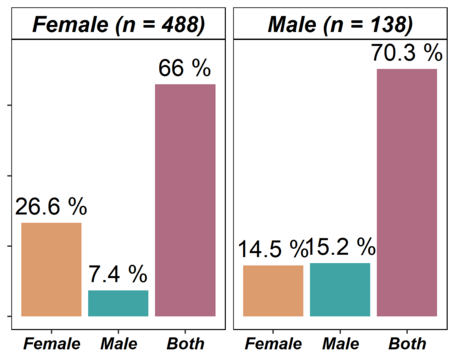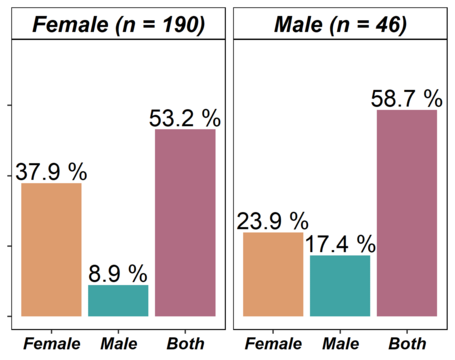#1 Blog: Analyzing time use of couples during COVID-19
"My day originally had 36 hours." - Analyzing time use of couples during COVID-19
By means of an online questionnaire, we collected data on multiple burdens during the strict restrictions while the COVID-19 crisis in Austria. One of them is the increased amount of unpaid work that had to be done, especially in couple households with children, as private and institutional care services suddenly ceased to be available. First results of our study show: For many parents, the period of initial restrictions implied stress, overwork, and the aggravated impression of an “unfair” distribution of (unpaid) work. Many disputes in partnerships arose around the appreciation of childcare and housework as work versus home office as work. One conflict that often was at the center: what is the worth of different activities and who, therefore, can work how many hours for pay?
As usually done in time use surveys, we asked people to think about their last working day and to report their use of time in intervals of 15 minutes. For many respondents, the limitation to 24 hours was challenging because the recent period has made concurrent activities indispensable (e.g. caring for children while working in home office, at the same time and in the same room). Feedback from respondents that current days do not have 24 hours, but rather 36 to 42 hours, reflects this overload.
"My day originally had 36 hours - I am probably superwoman" and "Actually, I do almost everything and besides that I look after the children" are two exemplary comments.
Paid vs. unpaid work
If we add up paid and unpaid work, women and men currently work between 11 and 15 hours per day. Single mothers worked the longest hours: on average almost 15 hours a day, 9 hours of those were spent for unpaid childcare and household tasks. However, the results for couples with children are similar: Mothers work 14.5 hours - 9.5 of those are unpaid while fathers reported 13.75 hours of work, 7 of those being unpaid. This relation is also evident in households with children under 15 where both parents are working at home during the exit restrictions. The survey responses highlight the challenge of combining home office and childcare: "I cannot tell you how impossible it is to combine childcare and home office".
The study revealed a large difference in the use of time within couples, “he” being the breadwinner and working full-time, while “she” works part-time: Those women worked 13.25 hours a day, 7.5 of those being unpaid, while men work 13 hours, 5 of those being unpaid. In households without children, however, working time - by extent and type (paid/unpaid) is distributed more equally: in those cases where both partners were working from home, each one worked 8 hours for pay and additional 3 hours unpaid on average.
We asked couple households that distributed unpaid work relatively equally before the COVID-19 pandemic about their expectations about the within household distribution of unpaid work in the future. The results reveal that 60% of those couples with a relatively equal distribution before the COVID-19 restrictions also shared domestic work roughly equal during the restrictions. According to females, in 27.8% of cases unpaid work is conducted mainly by themselves, while 11.5% of them reported that males are doing the largest share of it. The answers given by males suggest that women are responsible for the majority of unpaid work to a minor extent (22.1%), while they reported that males doing a larger share of it to a larger extent (18.6%).
Regarding the division of childcare tasks, our study reveals a clear backlash to more traditional gender roles: 50% of those families that split childcare tasks relatively equal within the household before COVID-19 reported that these tasks were shared relatively equal during the COVID-19 crisis as well. 40% of females answered that they are doing the largest share of childcare work, whereas only 23.9 % of males reported that childcare is now provided at the expense of women.
How can we explain the difference in the reports on who is bearing the largest share of unpaid work between men and women? First, fewer males participated in the survey. Second, we suspect that males that participated in the survey are living in partnerships with a more equal distribution of care work as compared to the population average.

Assessment of the distribution of household work

Assessment of the distribution of childcare
The distribution of unpaid work and the educational bias
Looking at the change of the within household distribution of unpaid work due to COVID-19 restrictions, our study reveals a clear educational gradient. One in three women with a university degree stated that during the lockdown, and compared to their partner, they were doing a larger share of unpaid work than before the COVID-19 crisis. The reason being that external services, such as babysitters or cleaning stuff, were no longer available and institutional child care facilities, such as kindergartens and schools, were closed. The increase in the share of unpaid work done by women is slightly less pronounced among women without a tertiary degree (one in four women). One explanation is that these women already spent more time on unpaid work before the restrictions as compared to women with a tertiary degree. However, also one-third of males with a tertiary education reported that their share of housework, especially childcare, increased during the restrictions imposed by the government.
During the COVID-19 crisis, unpaid work has become more extensive and seems to be more visible. Nevertheless, women reported that they have a feeling of doing most of this work alone. Exemplary comments on this issue from female respondents are: "I have the feeling that I do everything alone", "After work, he needs time off from his child - I have never had that before, even if he has been working 12 hours" or "Only the father has the right to take a break". This highlights the associated psychological stress women - especially mothers - have to bear.
